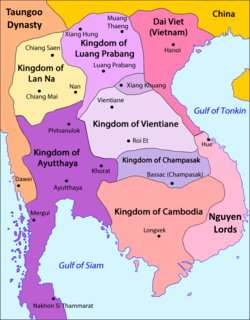Tây Sơn uprising
| Tây Sơn dynasty | ||||||||||||||
| House of Tây Sơn 西山朝 |
||||||||||||||
|
||||||||||||||
|
Map of Vietnam and Southeast Asia at the end of 18th century
|
||||||||||||||
| Capital |
Quy Nhơn (1778–93) Phú Xuân (1786–1802) |
|||||||||||||
| Languages | Vietnamese | |||||||||||||
| Government | Monarchy | |||||||||||||
| Emperor | ||||||||||||||
| • | 1778–93 | Nguyễn Nhạc | ||||||||||||
| • | 1788–92 | Quang Trung | ||||||||||||
| • | 1792–1802 | Cảnh Thịnh | ||||||||||||
| History | ||||||||||||||
| • | Nguyễn Nhạc proclaims himself Emperor Thái Đức | 1778 | ||||||||||||
| • | Nguyễn Huệ proclaims himself Emperor Quang Trung | 1788 | ||||||||||||
| • | Nguyễn Ánh captures Thăng Long | 1802 | ||||||||||||
| Currency | Văn | |||||||||||||
|
||||||||||||||
| Tây Sơn dynasty | |
| Vietnamese name | |
|---|---|
| Vietnamese | Nhà Tây Sơn |
| Hán-Nôm | |
The name Tây Sơn (Vietnamese: [təj ʂəːn]) is used in Vietnamese history in various ways to refer to the period of peasant rebellions and decentralized dynasties established between the end of the figurehead Lê dynasty in 1770 and the beginning of the Nguyễn dynasty in 1802. The name of the rebel leaders' home district, Tây Sơn, came to be applied to the leaders themselves (the Tây Sơn brothers: i.e., Nguyễn Nhạc, Huệ, and Lữ), their uprising (the Tây Sơn Uprising) or their rule (the [Nguyễn] Tây Sơn dynasty).
During the 18th century, Vietnam was under the nominal rule of the officially revered, but politically powerless Lê dynasty. Real power was in the hands of two warring feudal families, the Trịnh lords of the north who controlled and ruled from the imperial court in Hanoi and the Nguyễn lords in the south, who ruled from their capital Huế. Both sides fought each other for control of the country, while claiming to be loyal to the emperor.
Life for the peasant farmers was difficult. Ownership of land became more concentrated in the hands of a few landlords as time passed. The Mandarin bureaucracy was oppressive and often corrupt; at one point, royal-sanctioned degrees were up for sale for whoever was wealthy enough to purchase them. In contrast to the people, the ruling lords lived lavish lifestyles in huge palaces.
...
Wikipedia


